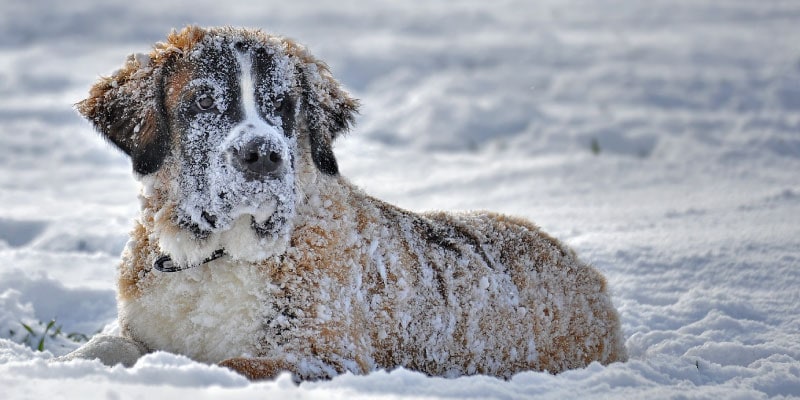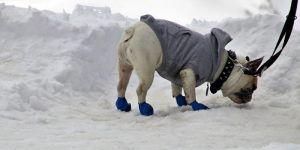We answer your most frequently asked questions about your dog at wintertime, to ease all your worries and save you a little cash.

If this is your first winter with your new pup, you might be asking yourself a million questions – from how to keep them warm, to whether you should.
It may even be tempting to splash out on expensive gear to keep your pooch comfortable, but unless you plan to go camping with your dog in winter, for the most part, you can keep your spending to a minimum.
How cold is too cold for a dog?
That’s a tricky question as it all depends on the breed and age of the dog. In our top tips to keep dogs safe in winter, we go into greater details about breed, size and coats.
However, generally here are the temperates where you need to start thinking about giving your dog extra protection against the cold:
- Temp 45°F / 7°C or below: Many cold averse breeds (think whippets and greyhounds) will need a jumper or jacket.
- Temp 32°F / 0°C: Small breeds, puppies, senior or thin-haired breeds will almost certainly need jumper or jackets.
- Temp 20°F / -6°C: All dog owners should pay special attention to their dogs and possibly even avoid going outdoors if the breed is not used to or is meant to be in cold weather for a prolonged amount of time.
This is only a guideline, of course, but generally, dogs can handle the cold without extra help far better than humans.
However, always listen to your dog, and if you find that your dog starts shivering at around 50°F / 10°C, then it’s fine to put on a jacket. Some of us need scarves in the fall, others don’t even think of wearing a hat until near Christmas. Dogs will have personal preferences too.
How do I tell if my dog is too cold this winter?
The good news is that even though dogs can’t speak, you sure know very quickly if they are unhappy. If you see any of the signs below, it means your dog is too cold this winter:
- They are shivering or shaking
- They whine or bark when you take them outside
- Reluctant to keep walking
- Keeps turning around to head home
- Lift paws significantly off the ground
- Keeps finding place to shelter and won’t move
- They have a hunched posture with a tucked tail as they walk
- They seem anxious or uncomfortable and become reactive
Whilst it is hard for dogs to get hypothermia, it isn’t possible. So don’t force them out for longer than is needed if they clearly don’t want to go or invest in extra jackets and boots if it’s going to be a long cold winter.
In extreme cases, dog hypothermia includes lethargy, muscle stiffness, weakness, and decreased mental alertness that leads to unconsciousness.
Do I need to buy extra blankets or dogs beds?
Unless you plan on keeping your house at 45°F / 7°C or below, generally most homes are warm enough for dogs to comfortably wander around without the need for extra blankets or winter beds.
Of course, that’s not to say you shouldn’t invest in a good dog bed anyway. All dogs should have a warm cozy spot to rest. However, if you do have a dog that clearly feels the cold, research the best type of dog bed to keep them warm.
An igloo-type bed is particularly effective at keeping even the most shivery dog in warmth and comfort.
Why is it important to check your dog after a winter walk?
Cold weather brings with it snow, ice, and other surprises, such as salted and gritted roads and pavements. As a general rule, it’s always good to wash their feet on their way home and dry their ears.
The three-step dog walks winter walk check:
- Check fur around toes: Compacted snow can lead to ice balls, which can be uncomfortable or painful
- Dry ears of snow: When it melts it can make their inner ears wet and lead to ear infections.
- Wash their feet of grit and salt: If you live in the city, this is a must unless you invest in snow boots.
Generally, this is only necessary during particularly cold weather, especially in the snow.
How long should I keep my dog out in the snow?
We hate to say it, but it is absolutely dependent on the breed. A St Bernard can probably happily do his usual hour-long walk, whilst you may want to keep your Chihuahua indoors until the cold snap passes.
A good indicator of how well adapted your dog is to the cold is to look at how their fur collects the snow. If your dog is bouncing around the snow, and the snow doesn’t seem to be melting on top of them, that means their undercoat is helping to create a waterproof layer.
However, if the snow is melting directly onto your pup’s skin and he’s getting wet, you’ll need to bring them inside sooner rather than later.
That said, assuming it’s not less than 20°F / -6°C and your dog seems happy, or you have decent coats and boots, half an hour is a general rough estimate for most short hair dog breeds.
Do I need to buy a dog coat or dog shoes?
When we started this dog blog article we promised you that you wouldn’t need to spend more money than you need to in order to keep your dog comfortable this winter.
However, by now you should have a good idea of whether your pet dog is able to deal with your climate. If you have a Labrador in the UK, you are probably fine with no extra equipment, unless you want to get them a waterproof jacket to avoid the mess when you get home.
If you have a Labrador in Quebec Canada, you need to get them a warm fleece jacket and maybe even some boots if you are planning on walking them regularly outside in the winter.
Equipment to keep your dog safe in Winter:
Depending on your climate, you might need:
- A rain jacket (for wet cold climates)
- A fleece jacket (for cold snowy climates)
- A LED light collar (for foggy days or long nights)
- A high visibility jacket (for dark night walks in the city)
- A good dog hairbrush (clean, brushed coats help insulate from the cold)
- Portable Pet Paw Washer Cup: (to clean feet of grit, snow and salt after the walk
Always listen to your dog
How cold is too cold? Whatever temperature your dog gets cold. That’s the simple answer.
It may take a Winter, but you’ll soon know what your pooch needs on the coldest of days, whether that’s to stay warm and snuggly inside, or jumping in the joy in the snow as if Christmas came early.
More importantly, before you buy or adopt a dog, do a little research on the type of breeds and find out their purpose.
A lap dog like a Pomeranian probably won’t care much for the snow, but a working dog like a Springer spaniel will rejoice in the outdoor exercise… even if they might need an extra layer to stay outside for longer.
Keep your dog safe in winter, and when in doubt, bring them inside.






